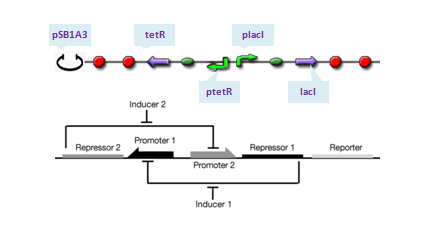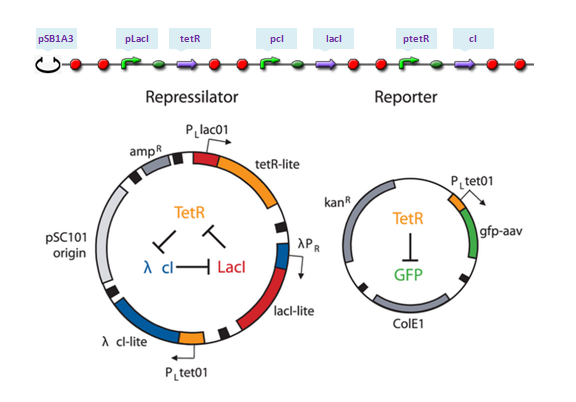|
|
| (71 intermediate revisions not shown) |
| Line 1: |
Line 1: |
| | {{Team:USTC_Software/Header}} | | {{Team:USTC_Software/Header}} |
| - | | + | {| cellpadding="15" cellspacing="0" |
| - | Using C-N Model we can model systems with great complexity
| + | |- |
| - | ==The simplest example with only E.coli cell==
| + | !|<font size="5">[[Team:USTC_Software/Transfer%20function%20of%20Part:BBa_F2620|pLux-LuxR repression system]]</font> |
| - | | + | !|<font size="5">[[Team:USTC_Software/Toggle-Switch|Toggle-Switch]]</font> |
| - | ===introduction===
| + | |- |
| - | As the simplest example, a model of a flask with only E.coli cells inside will be shown. Only one reaction will be considered: the replication of E.coli. However, it is not trivial. '''MoDeL''' enables users to add such an auto-catalytic replication reaction easily and conveniently. The minimal database used for this model could be download here.
| + | |valign="top"|[[Image:USTCs luxr gfp assembly.PNG|400px|thumb|center]] |
| - | | + | |valign="top"|[[Image:USTCs Toggle assembly.PNG|400px|thumb|center]] |
| - | ===database construction=== | + | |- |
| - | We only provide key points regarded with construction of this minimal database. To add the auto-catalytic reaction in the Reaction container, a species with only part E.coli is required. It has the simplest '''Chain-Node''' model format: only one chain with one part and no trees. The auto-catalytic reaction has one modifier and one product and they are both referred to E.coli defined in Species container. Since they are compartment-type species (species representing a compartment), attribute '''itself''' of '''compartmentLabel''' node in modifiers and products definitions should be set the same with label of the compartment they represent in the compartments definition. It ensures that the product and the modifier are the same, avoiding wrong mismatch of the product which is different with the modifier. Since number of E.coli cells will reach a stable level in a long time course, we use <math>k_{g}(1-C_{E.coli}/C_{max})C_{E.coli}V_{Flask}</math> as the reaction rate, where <math>k_{g}</math> is the growth rate of E.coli, <math>V_{Flask}</math> represents the size of E.coli, and <math>C_{E.coli}</math> and <math>
| + | !|<font size="5">[[Team:USTC_Software/Repressilator|Repressilator]]</font> |
| - | C_{max}</math> are concentration of E.coli and its max concentration in the flask, respectively. The negative sign in the rate equation indicates self-repression of E.coli cells.
| + | |- |
| - | | + | |valign="top"|[[Image:USTCs Oscillator assembling.PNG|400px|thumb|center]] |
| - | ===modelling and simulation=== | + | |} |
| - | [[Image:Ustcs Graph1.png|450px|thumb|right|Figure 1: Replication of E.coli cell]] | + | |
| - | Model written in '''SBML''' format is shown below. The dynamic curve of E.coli replication is plotted by time course simulation. Exactly speaking, dynamic behaviors of biological system are meaningless after 4000s because of termination of reproduction of E.coli. However, the curve is in qualitative agreement with that from experiments in the first and second stage of reproduction of E.coli.
| + | |
| - | [[Image:Ustcs XMLPNG 2010-10-14 123906.png|450px|thumb|left|Figure: SBML L2V4]] | + | |
| - | | + | |
| - | ==Basic example with pLac-LacI repression system==
| + | |
| - | | + | |
| - | ===introduction===
| + | |
| - | '''MoDeL''' provides poweful supports for description of interactions between two species. No interactions exist in the previous example. In this example, we will construct a plasmid backbone with promoter, rbs, coding sequence and terminator inserted in and transform it into E.coli. LacI repressor are produced after two steps of transcription and translation. It binds with itself to form a dimer and then a tetramer, which could bind with promoter LacI on the plasmid to repress the process of transcription. Besides, replication of E.coli cells, degradation of proteins and mRNAs, as well as dilution due to replication of cells, are also considered.
| + | |
| - | | + | |
| - | ===database construction===
| + | |
| - | Actually, it is a complex molecular process and takes many steps to complete a transcription reaction. It includes binding and initiation, elongation, and termination. So does translation reactions. The first version of '''MoDeL''' '''<font color='red'>DOES NOT</font>''' support transcription and translation reaction templates and they will be handled by our core program of '''iGame''' and thus no need to write in the database.
| + | |
| - | | + | |
| - | All binding reactions in the database demo are modeled using law of mass action. They are dimerization of two LacI repressors and that of two LacI dimers. LacI tetramers will bind with promoter LacI in the plasmid and thus repressing the expression of plasmid DNAs. However, '''MoDeL''' enables any mathematical model form for species-species interactions and is not constrained within only law of mass action. Users could change the reactants, modifiers, products, as well as kinetic laws arbituarily and validate their models via output of dynamic curves.
| + | |
| - | | + | |
| - | Species reaction templates are worth mentioning to show features of our new language '''MoDeL'''. It is never a easy problem to calculate degradation rates of proteins since different parts in a fused protein may have different degradation rates and the overall rate is still unknown. What's more, a protein in '''MoDeL''' may have different protein chains and it is more complex to determine the overall rate. In the demo database, we assume all proteins with no parts in bound state have a uniform degradation rate. Proteins with more than one chains are considered stable and non-degradable. It is similar for degradation of mRNA molecules. Only mRNAs with single chain degrades at the same rate.
| + | |
| - | | + | |
| - | ==Demo of oscillator==
| + | |
| - | ==Demo with reverse parts(Demo of toggle switch)==
| + | |
| - | ==Demo with environmental conditions==
| + | |
| - | ==Demo with substituent transfers==
| + | |
| - | ==Demo with multi-compartment reactions==
| + | |
| - | ==Demo with complex binding product==
| + | |
 "
"


